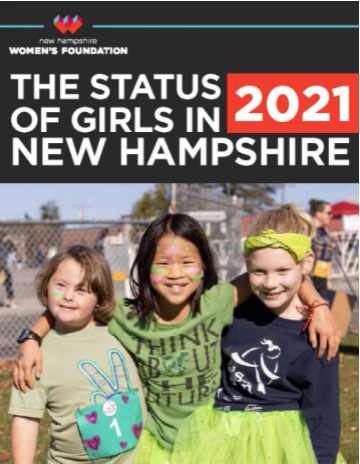The inaugural report is the first and only data-driven report on girls in New Hampshire
covering 32 indicators on girls’ well-being
CONCORD – Today the New Hampshire Women’s Foundation announced the release of The Status of Girls in New Hampshire, a data-driven report on the well-being of girls in the Granite State.
The report provides 32 indicators in demographics, education, economic security, health, substance use and safety. This report is a snapshot of a point in time. It will serve as a benchmark to measure future success or shortcomings.
The 20-page report can be viewed here: https://nhwomensfoundation.org/statusofgirls/
These indicators highlight a strong, smart, resilient, and diversifying population of girls with endless potential. The data also highlight disparate outcomes by gender, race, ethnicity, and geography. These disparities present opportunities for investment and involvement to support girls.
“What’s unique about the Women’s Foundation publications is our gender lens. We know how vital data driven research is to gender equality. The Women’s Foundation believes that data-driven research is essential to the work of our fellow nonprofits, to policymakers, school districts, advocates, parents, and to the public,” said CEO Tanna Clews. “We invested in this research because if the public discourse about issues affecting girls is based in data, we will achieve better outcomes for girls and move toward a more equitable future for all New Hampshire children.”
Specific takeaways include
• Girls are excelling:
• Girls score similarly to boys in math and science in subject proficiency tests, upending a trend and a gender bias that is crucial to closing the gap in girls work and leadership in the STEM fields
• Diversity is increasing:
• While the majority of girls are white, there has been a a 61% increase in girls of color since 2006
• Disparities persist between girls and boys:
• Though teen contraception use, including IUDs and birth control, has increased, condom use, which protects against STIs, has decreased. The chlamydia rate for girls is three times greater than boys, and increased 43% since 2014.
• Girls are four times more likely to experience sexual violence than boys
• Disparities persist by race, ethnicity and geography
• New Hampshire girls are more likely to suffer from poor mental health than boys. Girls living in the Winnipesaukee and Greater Sullivan regions have the greatest depression and suicide consideration rates. Hispanic/Latina and Black/African American girls have the highest depression and suicide contemplation rates.
Going forward, the Status of Girls and the Status of Women reports will be released consecutively every-other year to provide consistent data and insight on the status of women and girls in the state.
About New Hampshire Women’s Foundation
The New Hampshire Women’s Foundation invests in opportunity and equality for women and girls in the Granite State through research, education, advocacy, grantmaking, and philanthropy. Learn more at NHWomensFoundation.Org.





